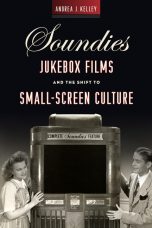During the 1940s about 1,850 “Soundies” were produced in the US, destined to be played on 5,000 special standalone film machines in circulation nationwide. Those 16mm short films with a musical content were presented in coin-operated movie jukeboxes that were known as “Panorams,” which could be found in consumer places or likely in any place where people were waiting or in transit: in train stations, bars, restaurants or bus depots.
 The 1940s were the time when films or small feature movies entered not only public or educational spaces but – since the military too used the 16mm technology – they became part of everyday life during the war years. For a brief period of time, the boxes were also kept in service installments, set up with instructional military training films.
The 1940s were the time when films or small feature movies entered not only public or educational spaces but – since the military too used the 16mm technology – they became part of everyday life during the war years. For a brief period of time, the boxes were also kept in service installments, set up with instructional military training films.
As TV had not yet invaded American homes (as it would in the late 1940s when a national standard was developed), going to the movies at least once a week had become a standard ritual for most Americans (with a peak in 1946 of 82 million weekly moviegoers). The Panoram was the first step from the large-scale silver screen to the miniaturized TV set screen of the years to come.
So cinema technology in combination with short films – even if transformed into a small Panoram box – was a common thing and seen as a commodity by most people. From a film historian’s point of view, however, Soundies define an individual genre with specific modes of production, themes, recording technology and logistics involved. “…Soundies on the Panoram modeled emerging trends in film and media engagement, including the shift from large screens to small, from feature-length films to short formats, from collective to private viewing practices, and from site-specific film venues to ubiquitous scree encounters.”
Heavily hit by the 1942 AFM (American Federation of Musicians) recording ban – that lasted until November 1944 – for members which allowed only musical recordings for the film industry and the armed forces, due to the war economy and subsequent limitations of production and recording means, no new material was recorded. This made Soundie production extremely difficult, as the content was mostly musical in nature but then was altered to include theatrical acts, vaudeville performances, comedy and folklore performances. (Actually, short musical clips originated already with the Warner Brothers jazz shorts of the 1930s).
At any rate, looking back today, the Soundies are a real treasure that represented a wide variety of artists. And “… one of their defining characteristics when taken in total is their engagement with multicultural motifs and styles,” explains author Kelley, assistant professor of media studies at Auburn University School of Communication and Journalism in Alabama. “Soundies employ diversity for visual effect, appealing to exoticism or evoking cultural tourism while drawing on popular musical styles.”
In this manner, Soundies inform about the public’s musical tastes from 1940-1946, roughly. The musical content included Hawaiian songs, hillbilly music, big band swing, tap dancers, ballads, rumbas and anything that would be popular – and naturally the Panoram’s success was connected to the (prior) distribution of the songs as shellac copy or by radio. What people missed back then was the unity of the songs: the performers, their respective faces and – often enough – the dance that went along with it. (With the music-video today, that information comes as a unit.)
“By looking beyond conventional sites of moving image and the dominant industrial practices of Hollywood, this book charts the changes in media viewing through the quotidian spaces of Soundies short musical films playing on coin-operated Panoram film jukeboxes in order to examine how U.S. screen culture became both spectacular an ordinary and almost always within our reach.”
Due to the fading novelty and sensation the shorts created by the end of the war, Soundies Distributing Corporation, the company behind production and circulation folded in 1946. The Panorams simply vanished from the public eye, only a few survived, refurbished as peep-show booths in arcades, for example. In the 1960s, a “new” development was started by the introduction of a more modern jukebox film machine, the Scopitone, that connected to the success of the Panoram.
Nevertheless, Soundies played an important role in the cultural discourse that took place in the encounters with short films, small screen-technologies and their audiences. A development, by the way, that continues until today, as (not just young) people again watch clips, entire movies or animated cartoons on the small screens of their cell phones or tablets.
This short book here in its first half highlights the technical and material qualities of the media and the presentation. The second half concentrates on the aesthetics, racial representations and the localization of the product at that time in the US. Chapter five, “’A Swing Half Breed,” dealing with representations of black musicality (16% of the Soundies feature black artists) may be of particular interest to some and is recommended.
Review by Dr. A. Ebert © 2018
Andrea J. Kelley. Soundies Jukebox Films and the Shift to Small-Screen Culture (Techniques of the Moving Image). Rutgers University Press, 2018, 194 p.
